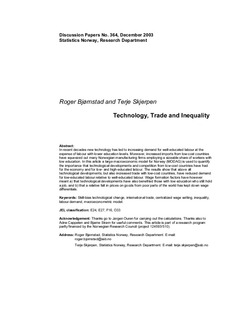Technology, trade and inequality
Working paper

Åpne
Permanent lenke
http://hdl.handle.net/11250/180531Utgivelsesdato
2003Metadata
Vis full innførselSamlinger
- Discussion Papers [1002]
Sammendrag
Abstract:
In recent decades new technology has led to increasing demand for well-educated labour at the
expense of labour with lower education levels. Moreover, increased imports from low-cost countries
have squeezed out many Norwegian manufacturing firms employing a sizeable share of workers with
low education. In this article a large macroeconomic model for Norway (MODAG) is used to quantify
the importance that technological developments and competition from low-cost countries have had
for the economy and for low- and high-educated labour. The results show that above all
technological developments, but also increased trade with low-cost countries, have reduced demand
for low-educated labour relative to well-educated labour. Wage formation factors have however
meant a) that technological developments have also benefited those with low education who still hold
a job, and b) that a relative fall in prices on goods from poor parts of the world has kept down wage
differentials.
Keywords: Skill-bias technological change, international trade, centralized wage setting, inequality,
labour demand, macroeconometric model.